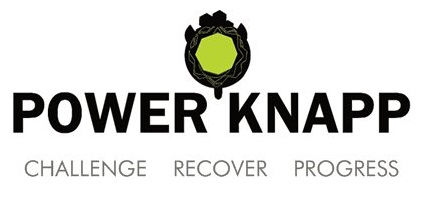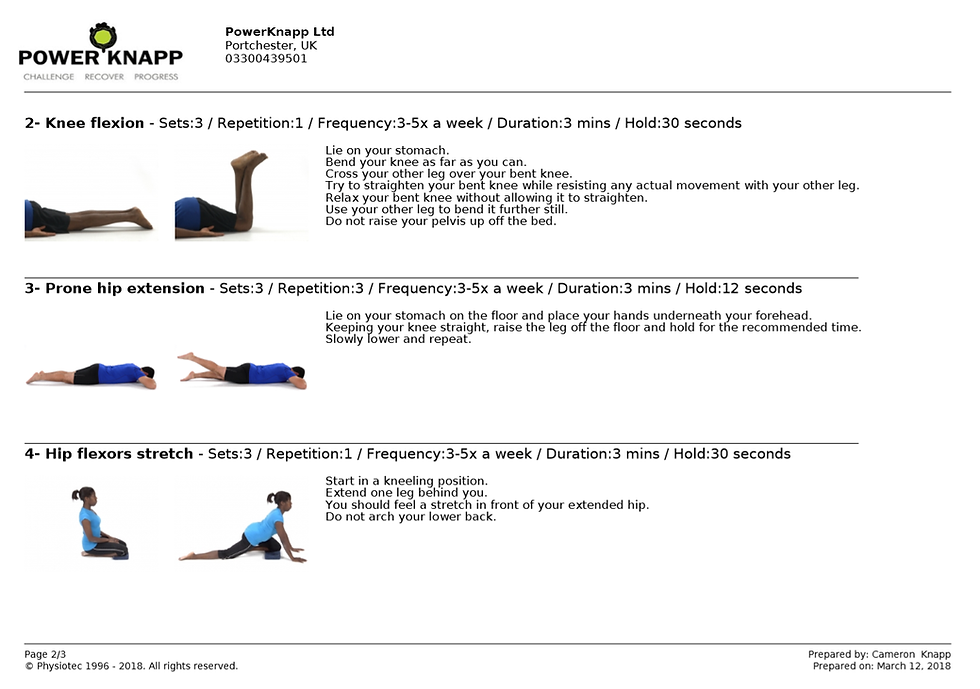Here at PowerKnapp we issue every new client a batch of exercises that reflect their specific and individual aches and pains. Period. How many exercises will depend on how complex the issue their suffering from is or simply the number of issues they have. There is also the matter of whether we believe their aches and pains are to be the result of general tension, weakness and/or overuse in a particular muscle group. The latter would put clients into PowerKnapp's very own Strengthening Plan from our massage treatment plans. So why do we issue exercises and what's the benefit in doing so?

And no, it's not because we want to give you homework for the sake of it 😉 We aren't school! They aren't compulsory, but, they will prove invaluable to your recovery.
Suffering from aches, pains or injury - long or short term - can be frustrating and negatively impact not only your physical wellbeing but your mental wellbeing too. And sitting at home not being able to do anything about those aches, waiting for the next appointment to roll round isn't much better.
Home Exercise Programs, or HEP's, are there so clients can make a positive impact to their aches and pains. Here at PowerKnapp, we use a sophisticated HEP specific software called Physiotec which helps us to put together a personalised HEP with an extensive range of exercises to choose from, which are displayed clearly and explained thoroughly in the print outs. It gives client the ability to manage their injuries, even if it's only a little. It makes the client feel productive, keeps them motivated and gives them something to aim for and focus on. It gives the client control. And that is one of the most important parts to being a good therapist; making the client have some independence and not feel like they are entirely dependant on the service. And, yes, the therapist is still relevant as the exercises won't be the sole solution - a bit of manipulation whether it be massage or physio is always preferred and often best! But the HEP is a big part of the equation for a client to becoming pain free.

Another really important aspect of the HEP's is continuing progress beyond the clinic room. A client may see a therapist once a week, fortnight or even month, meaning there's lot of time between sessions that could be put to use to help improve the issues a client faces. The HEP means that a client can make steps forward with their progress outside their sessions, recovering faster, understanding their own bodies better and making full use of their time and resources. A client that does the HEP on a regular basis is a motivated one and hence will see the benefits far quicker.

We issue a clients HEP after the first session, so they instantly have this control and potential ongoing progress. The exercises are often very easy to begin with, as HEP does sometimes highlight aspects of the injury that may not have been observed in the Initial Consultation. If certain exercises are too easy or too difficult for that matter, tells us a lot about the condition and wellbeing of particular muscle groups and allows us to adapt the plan to keep up with our understanding of your issues, and personalising the service as best as we can to make sure the treatment is effective and you get the most out of it.
However, I do appreciate no all HEP's are perfect - even mine! It's a shared responsibility between client and therapist to discuss the exercises to make them reflect the needs of the client more accurately. Although all of ours are personalised, we know not every therapist is the same. If a therapist is either inflexible, unable to justify the exercises or simply gives you pre-prepared generic HEP, you should discuss this with them and explain that a more personal HEP would preferable if possible if you feel confident that the exercises you have do not reflect your discomfort.

Although HEP's are mainly designed to respond to a particular ache/pain/injury a client already has, HEP's don't have to be entirely responsive. They can be used long after the injury as a means of prevention. They will help to keep the muscles and joints in use whilst keeping them strong to ensure past injuries don't haunt you. After all, when you've got rid of all those pains, do you really want them back? So it's worth keeping hold of them for long after the injury and aches have passed.
In this respect, HEP's don't have to be just short term, but rather an ever changing and adapting set of exercises to reflect a clients current concerns and niggles. This long term approach increases clients awareness of their own body and the muscles, which can prove invaluable when it comes to avoiding and managing injury. This transforms the recovery style HEP and massage to a more long term maintenance approach to keep injury a bay and keep you at your best for as long as possible.
So when your therapist (potentially me 😉) give you some exercises, don't disregard them on the kitchen counter. They may not be compulsory but they're no optional extra either. Even you don't like the exercises, try them, see what works and what doesn't. There is a lot to be learnt from having a discussion about the exercises set which may improve the rate of recovery and the speed at which the therapist can get you back to your peak or even detect early signs of other problems!
Help us, help you. Use your HEP 💪

Comentarios